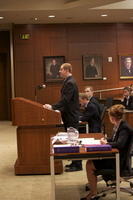JAG Corps Work Can Be on the Battlefield as Well as in the Courtroom, Houck Says
What is the United States Navy looking for in the lawyers it selects for the Judge Advocate General’s Corps? Not surprisingly, Vice Admiral James W. Houck, Judge Advocate General for the Navy, answered, “We’re looking for good lawyers.” But, he added, a few other qualities are important: Being a good team player and being willing to take on difficult assignments, sometimes in difficult places.
Houck described the work of the JAG Corps and his own career at an “On the Issues” session Thursday with Mike Gousha, distinguished fellow in law and public policy at Marquette University Law School.
JAG Corps positions have become highly sought, especially in today’s difficult job market for lawyers, Houck said. He described the corps as “a world-wide law firm” with 2,300 employees. The initial commitment of a lawyer joined the corps is for four years, but more than 90% seek to serve longer. And “people stand in line” for assignments in a place such as Afghanistan, Houck said.
He said the JAG Corps has had a good association with Marquette and there have been at least seven Law School grads in the corps in recent years.
The role of lawyers in the Navy is far broader than many people realize. Members of the JAG Corps work both as prosecutors and as defense lawyers in military judicial proceedings and they provide legal help to members of the Navy and their families. But, Houck said, they are also involved in combat issues that put them on the frontlines of combat. Those issues can include advising commanders on what is a legally valid target or an acceptable risk of collateral damage. “Lawyers are integrated in ways people would never imagine,” Houck said.

